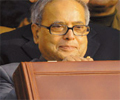
Presenting his second consecutive budget for the Fiscal Year (FY) 2010-11 in the United Progressive Alliance (UPA) government, Finance Minister of India Pranab Mukherjee has made a reliving announcement for the individual taxpayers by raising slabs in tax levels. FM has also announced to introduce Direct Tax Code and Goods and Service Tax (GST) pattern in the system by April 01, 2010. With these new tax patterns, India's tax system will become the world-class tax system and tax collections will also be improved.
Pranab Mukharjee, who was rated one of the world's among top 5 Finance Ministers (FMs) for the year 1984 has emphasized on growth consolidation, improving investment environment, better transparency and public accountability in his budget presentation.
Giving an adequate relief to the individual taxpayers, FM has announced a 10% income tax (I-T) levied on the annual income of Rs.1,60,001 to Rs.5,00,000; 20% on Rs.500001 to Rs.8,00,000 and 30% on above Rs.8,00,000. However, he has not enhanced the basic threshold limit for income tax exemption and remain it at Rs.1.60 lakh.
For the women, the basic threshold limit will be remain at Rs.1,95,000 and for the senior citizens, it will also be at par the present FY's level of Rs. 2,25,000. Moreover, FM has also eased the maximum tax saving limit from currently Rs.1,00,000 to Rs.1,20,000 but for it the tax payees will have to invest in the longterm infrastructure bonds.
This long-term infrastructure bond will support the realty sector, which was hit worst in the present FY.
However, this announcement of I-T relief would not prove much effective for the lower income group employees as the basic threshold exemption limit has not been enhanced while their salary have gained 40 – 70% zoom after implemention of the modified sixth pay commission recommendation, as experts analyse.
From the new financial year, two new tax systems - Direct Tax Code and GST are proposed to be implemented by April 01, 2010. The introduction of GST will lead to the elimination of taxes such as octroi, Central sales tax, State level sales tax, entry tax, stamp duty, telecom licence fees, turnover tax, tax on consumption or sale of electricity, taxes on transportation of goods and services, and other multi-level taxes.
In Budget 2010-11, FM has charged an additional central excise duty of Re.1 per litre on Petrol and diesel and proposed to enhance the basic duty on petroleum products too. On non-petroleum product, he has proposed to enhance the ad valorem from 8% to 10%.
FM has estimated a total expenditure of Rs.11,08,749 crore, 8.6% more as against last year's budget in today's budget proposal. The proposal of planned expenditure is estimated at Rs.3,73,092 crore, 15% more from previous year's while the non-planned expenditure is estimated to Rs.7,35,657 crore, a rise of 6% from the last year's.
The proposal of fiscal deficit has been estimated to freeze at 5.5% of the Gross Domestic Product (GDP) for FY 2010-11 from current FY's of expected 6.9% that will result a sum of Rs.3,81,408 crore. The government would try to tighten it to 4.8% and 4.1% in the next two fiscals, proposed Pranab.
The net market borrowing is expected to a sum of Rs. 3,45,010 crore, quite sufficient for fulfilling the credit needs of private sector, while the gross tax receipts is pegged at Rs.7,46,651 crore in which non-tax receipt may be at Rs.1,48,118 crore, he added in his budget presentation speech.
Here are the highlights of the Budget 2010-11:
|
|
Read More: Cod


Comments:
rajanikant
December 27, 2010 at 12:00 AM
I found it very informetive . . . .